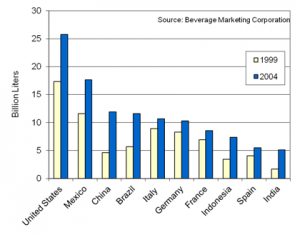In May 2017, Augsburg approved a new Policy on Bottled Water that aims to reduce waste and greenhouse gas emissions and support the provision of water as a human right and not a commodity. To support policy implementation as we #LoveLocalWater, Fall 2017 Environmental Connections (ENV 100) students created projects to address knowledge gaps, resource needs, and communications opportunities. Check back each week in January as we feature a blog series on different aspects of bottled water written by one of those project groups!
By Josie Slavik (’21)
When you think of clean drinking water, you may not think of it as a social issue. But the availability of clean drinking water is very much a social issue. Places all over the globe lack clean water, even places as close as Flint, Michigan. However, some places don’t even have the infrastructure to access clean water to begin with. There are areas where people have to walk miles to drink dirty water. This leads to disease and a life revolving around water. With areas where water is so difficult to come by, you wonder how it’s become such a widely sold product in other areas. The water bottle industry grows by 8-10% each year, which is much higher than many other beverages. The US has access to many lakes and rivers to get our drinking water. However, many industries threaten the purity of the water. Oil fracking companies threaten surrounding bodies of water with chemicals that could largely pollute the water, and oil pipelines cross major aquifers and bodies of water, threatening leaks and contamination. As we saw with Standing Rock and other pipeline activism, people are willing to protect the water that sustains them by risking their lives.
For a country that mostly has readily accessible water right in our homes, we sure do buy a lot of bottled water. I and many others can walk down the hall and get as much clean water as we please from the tap, and yet we buy bottled water. Places that don’t have access to this clean drinking water should be the ones with access to the commodity that is bottled water. However, in light of convenience and revenue combined with lack of knowledge, many people who don’t need bottled water buy it anyways. Below is a chart of how much bottled water is consumed in different countries.

In this chart it is shown that the US had the largest bottled water consumption. The lowest on the chart is India even though they themselves have water quality issues. In India 163 Million people lack access to safe water. One large water supply in India is the Ganges River. It is very polluted with garbage and waste. It makes the bottled water use seem very backwards. A place like the US, where 99% of people have access to clean, safe, cheap drinking water, is the largest consumer of it.
“Studies suggest that Americans with income of $60,000 or more are 35% more likely to purchase bottled water. However, even though Black, Hispanic, and Asian household’ income are generally less than average, these groups are more likely to purchase bottled water”. This is an intriguing trend with complex ties to poverty, marketing, infrastructure, and background. As I’ve learned in school, some people have backgrounds and experiences that cause them to believe that bottled water is cleaner and tap isn’t to be trusted. Depending on where and how someone grew up, they may only trust the bottled water. When there is a lack in knowledge of one’s drinking water, it can be confusing.
In Minneapolis, we are lucky to have clean drinking water straight from our taps. This makes bottled water unnecessary. However, some people who aren’t used to having access to clean water or have false assumptions about tap water still rely upon it. Some people may be unaware that our drinking water is safe and just as clean as bottled water. But the lack of knowledge isn’t the only reason people buy bottled water. Many times it’s bought for its convenience. Many like to live without burden and to have faster lifestyles. Buying bottled water takes out the time of needing to fill reusable water bottles or remember to bring your own. You may not even be able to fill your bottle in certain places if water fountains aren’t available. Or you may not have your own bottle to bring. But what about when we get to larger scale bottled water use and sales outside of our homes? There are major events and buildings that still rely heavily on bottled water, such as for sporting events and concerts. The sports teams and venues may even rely on the revenue of these sales. Although they may rely on it’s sale, I feel it’s important to encourage people to bring reusable water bottles for these events. If venues would be heavily affected by reusable water bottle use, then they could turn to selling reusable water bottles and try to offer a place to fill them. This way they can still get their revenue while being environmentally conscious. The sale of reusable water bottles also gives convenience to those who may not have one yet, or have forgotten theirs.
With all this talk about bottled water it brings up the question of what happens to the bottles after they’re used. Do they get recycled? If people don’t recycle, what’s preventing them from doing so? It seems that around 32 percent of water bottles are currently recycled. This number, however, is rising gladly. But even though the water bottles are recycled, they’re generally not fully recycled. Many newly made water bottles are only partly made from recycled materials. The bottles that aren’t recycled end up in landfills or the environment. Many bottles are also exported to plastic manufacturers and turned into things like clothing, carpets and packaging. This means every bottle is using newly made plastic and not fully recycled plastic. In an Upworthy article I read there are many reasons as to why someone doesn’t recycle at all. The main reason people gave is that there isn’t a recycling bin easily accessible. If they don’t have a place to put the recyclables I can see how it could become difficult. Other reasons include forgetfulness and how time consuming it is. This falls under the convenience factor. People buy the plastics in thought of convenience and use the same excuse when asked about recycling it. I also noticed the lack of education come up as an excuse. If a person is unaware what they are allowed to recycle they are less likely to do so.
All of these trends bring up questions to think about in terms of who benefits from bottled water, who is harmed by its bottling and disposal, and how it’s more than just the plastic to be concerned about when thinking about bottled water.

